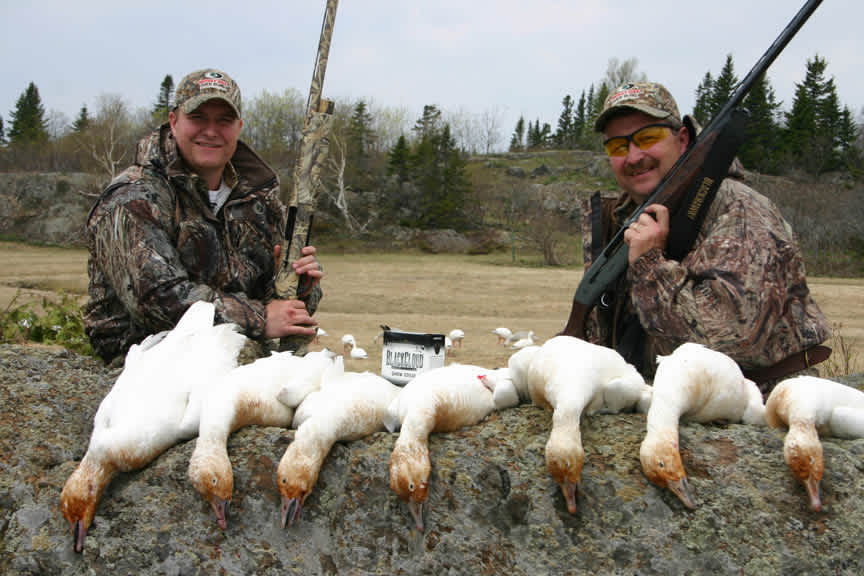Hunting “the Other” Spring Snow Geese
Bill Miller 02.09.15

March will soon be here! It’s when hopelessly devoted waterfowl hunters begin thinking about (and pursuing) spring season snow geese. Hunting these birds as they follow the snow line and the warming weather north has become extremely popular throughout the birds’ range. As many or more light geese are taken during spring seasons as in the fall. Outside of the occasional dove shoot in Mexico, good days of spring snow goose hunting are the closest thing North America offers to the high-volume wingshooting of South America and elsewhere.
Most of the focus is on the white and slate blue birds migrating up the Central Flyway from Texas and Arkansas through Missouri and Nebraska, into the Dakotas and over the border into Manitoba, Saskatchewan, and Alberta. The birds in this flyway are technically lesser snow geese, which exhibit the frequent mix of blue color-phase geese in the flock.
Lesser snow geese in the prairies are plentiful (actually overpopulated, which is the reason there is a spring hunt) and fun to hunt, but extremely wary. These birds are almost constantly on the move and will turn back south when snowstorms cover feed fields in their path.
 Lesser known, but frequently more civilized, spring snow goose hunting happens in the Northeastern United States and on up into Quebec. The birds pursued here are the Atlantic Flyway’s greater snow geese. Though not as numerous overall, these birds make up for in size what they might lack in gross population. On average, greater snow geese are about 30 to 50 percent larger than their Central Flyway cousins.
Lesser known, but frequently more civilized, spring snow goose hunting happens in the Northeastern United States and on up into Quebec. The birds pursued here are the Atlantic Flyway’s greater snow geese. Though not as numerous overall, these birds make up for in size what they might lack in gross population. On average, greater snow geese are about 30 to 50 percent larger than their Central Flyway cousins.
These birds show little to no blue color phase in the flock. You’ll look on them in a field, tidal flat, or in the air and see nothing but pure white birds, save for their rust-stained heads. Greater snow geese make use of agricultural fields to be sure, but spend much of the winter eating tubers that must be pulled out of mud containing high iron and clay content. This results in the snowy white feathers on their heads being stained a rusty orange color that stands out significantly when you are viewing individual birds up close.
Spring hunting for Atlantic Flyway snow geese is conducted in the northern half of the Eastern seaboard including the states of Maryland, Delaware, Massachusetts, New York, and Vermont. Then it’s just a hop over the border into Quebec where the birds are primarily hunted in the corridor of the St. Lawrence River.
One of the finest waterfowl hunts I’ve ever enjoyed was with Domaine de Ille au Canot (Canoe Island) off of Montmagney, Quebec. Hunting this tiny island is definitely different than mainland snow goose hunting, especially prairie hunting.
 When the time is right, the birds cover up the island, but hunting them incorrectly or under the wrong conditions would educate the birds and they would leave and avoid the tiny island completely. So you wait for the wind, tide, and sky conditions to coincide properly, then you rush out to the preset blinds and decoy spreads to hunt while things are right. Shooting is usually fast and furious—nearly continuous. Then as soon as conditions fall out of sync, you pull out of the fields to wait for the next alignment of the stars to hunt again.
When the time is right, the birds cover up the island, but hunting them incorrectly or under the wrong conditions would educate the birds and they would leave and avoid the tiny island completely. So you wait for the wind, tide, and sky conditions to coincide properly, then you rush out to the preset blinds and decoy spreads to hunt while things are right. Shooting is usually fast and furious—nearly continuous. Then as soon as conditions fall out of sync, you pull out of the fields to wait for the next alignment of the stars to hunt again.
This may sound like a frustrating way to hunt, but it isn’t. During the stay on the island you are accommodated in a fantastic lodge with private rooms, gourmet dining, and a long porch with rocking chairs overlooking the expanse of the St. Lawrence. Most of the time there are tens of thousands of geese feeding on the tidal mud flats as far as you can see in every direction. Many are walking right through the grounds of the lodge. The warming spring sun on your face and arms as you sit in a rocker waiting for the call to hunt is a wonderful spring tonic.
Many other outfitters stand ready to assist hunters in pursuing greater snow geese in the Northeastern United States and Eastern Canada with more traditional styles of field hunting. And an added bonus is that the spring hunting for greater snow geese tends to peak a bit later in the spring than it does for lessers on the prairies—so the devout goose hunter can enjoy it all!
 Tip of the Week
Tip of the Week
When the weather warms, there’s no more mosquito-ridden place in the world than a goose hunting pit blind. Just one ThermaCELL can handle that problem for a four- or five-hunter blind. The key is suspending the unit in such away that air can circulate around it. Don’t just lay it down on the shell shelf or the bench and call it good. Suspend it on a cord from the top of the blind or on a stick stuck in the ground or between the planks in the walls. Be sure to make a ThermaCELL a permanent resident in you blind bag so you have it every time you go goose hunting this spring!

These insights brought to you by Federal Premium Ammunition, ThermaCELL, Camp Chef, and the Quebec Outfitters Federation.


